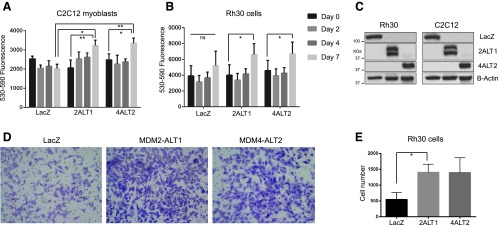Figure 3.

MDM2-ALT1- and MDM4-ALT2-expressing cells show increase in migration and anchorage-independent growth. Rh30 RMS cells and C2C12 myoblasts were transfected with LacZ, MDM2-ALT1, or MDM4-ALT2 expression constructs. The cells were used for soft agar and/or matrigel invasion assays. (A) C2C12 cells expressing LacZ, MDM2-ALT1, or MDM4-ALT2 were seeded. Their growth was monitored at days 0, 2, 4, and 7 after seeding. Data from three independent experiments with triplicate wells for each transfection group are represented graphically with SEM error bars. C2C12 cells expressing MDM2-ALT1 (P = .0117) and MDM4-ALT2 (P = .0054) show significantly more anchorage-independent growth in soft agar at day 7 compared to LacZ-expressing cells. Additionally, comparison of growth in soft agar between days 0 and 7 showed significant increases in the MDM2-ALT1 (P = .0025) and MDM4-ALT2 (P = .0296) groups but not in LacZ. (B) Rh30 cells expressing LacZ, MDM2-ALT1, or MDM4-ALT2 were similarly assayed for anchorage-independent growth for 7 days in soft agar. MDM2-ALT1 (P = .0109) and MDM4-ALT2 (P = .0389) expression caused significant increase in growth of Rh30 cells at day 7 compared to day 0. LacZ-expressing Rh30 cells however showed no significant changes in growth in soft agar between days 0 and 7. (C) Western blots confirming expression of LacZ, MDM2-ALT1, and MDM4-ALT2 in Rh30 and C2C12 cells at 24 hours post nucleofection. (D) Rh30 cells expressing MDM2-ALT1 and MDM4-ALT2 show increased migration through matrigel-coated membranes (8-µm pore size) compared to Lac-Z-expressing Rh30 cells. Representative x10 magnification images of Rh30 cells post migration are shown here. (E) The matrigel invasion experiments were performed in three independent trials, and the number of invasive cells was counted and represented graphically with SEM error bars for each group. Unpaired Student's t test comparing the mean number of cells in each group with LacZ-expressing cells indicated a statistically significant increase (P = .0417, 95% CI) in invasive behavior of MDM2-ALT1-expressing Rh30 cells.
